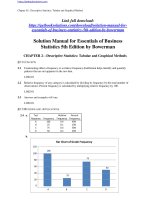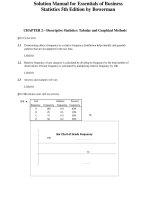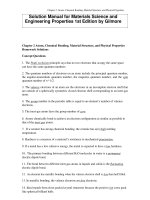Solution manual for polymer science and technology 3rd edition by fried
Bạn đang xem bản rút gọn của tài liệu. Xem và tải ngay bản đầy đủ của tài liệu tại đây (623.79 KB, 7 trang )
Solution Manual for Polymer Science and Technology 3rd Edition by Frie
Full file at />
Solutions Manual for
Polymer Science and
Technology
Third Edition
Joel R. Fried
Upper Saddle River, NJ • Boston • Indianapolis • San Francisco
New York • Toronto • Montreal • London • Munich • Paris • Madrid
Capetown • Sydney • Tokyo • Singapore • Mexico City
This text is associated with Fried/Polymer Science and Technology, Third Edition (9780137039555)
Copyright 2014, Pearson Education, Inc. Do not redistribute.
Full file at />
Solution Manual for Polymer Science and Technology 3rd Edition by Frie
Full file at />
The author and publisher have taken care in the preparation of this book, but make no
expressed or implied warranty of any kind and assume no responsibility for errors or
omissions No liability is assumed for incidental or consequential damages in connection
with or arising out of the use of the information or programs contained herein.
Visit us on the Web: InformIT.com/ph
Copyright © 2015 Pearson Education, Inc.
This work is protected by United States copyright laws and is provided solely for the use
of instructors in teaching their courses and assessing student learning. Dissemination or
sale of any part of this work (including on the World Wide Web) will destroy the
integrity of the work and is not permitted. The work and materials from it should never
be made available to students except by instructors using the accompanying text in their
classes. All recipients of this work are expected to abide by these restrictions and to
honor the intended pedagogical purposes and the needs of other instructors who rely on
these materials.
ISBN-10: 0-13-384559-1
ISBN-13: 978-0-13-384559-4
This text is associated with Fried/Polymer Science and Technology, Third Edition (9780137039555)
Copyright 2014, Pearson Education, Inc. Do not redistribute.
Full file at />
Solution Manual for Polymer Science and Technology 3rd Edition by Frie
Full file at />SOLUTIONS TO PROBLEMS IN POLYMER SCIENCE AND TECHNOLOGY,
3RD EDITION
TABLE OF CONTENTS
Chapter 1
Chapter 2
Chapter 3
Chapter 4
Chapter 5
Chapter 7
Chapter 11
Chapter 12
Chapter 13
1
5
14
24
28
36
40
51
52
CHAPTER 1
1-1 A polymer sample combines five different molecular-weight fractions, each of equal weight. The
molecular weights of these fractions increase from 20,000 to 100,000 in increments of 20,000.
Calculate M n , M w , and M z . Based upon these results, comment on whether this sample has a
broad or narrow molecular-weight distribution compared to typical commercial polymer samples.
Solution
Fraction #
1
2
3
4
5
Σ
=
Mn
5
Wi N
∑=
i =1
Mi (×10-3)
20
40
60
80
100
300
Wi
1
1
1
1
1
5
Ni = Wi/Mi (×105)
5.0
2.5
1.67
1.25
1.0
11.42
5
=
43,783
1.142 × 10−4
5
=
Mw
∑W M
i
i
=
5
∑Wi
i =1
300,000
= 60,000
5
i =1
5
Mz
=
∑W M
i
2
i
=
∑Wi M i
i =1
5
4 × 108 + 16 × 108 + 36 × 108 + 64 × 108 + 100 × 108
= 73,333
3 × 105
i =1
M z 60,000
=
= 1.37 (narrow distribution)
M n 43,783
1-2 A 50-gm polymer sample was fractionated into six samples of different weights given in the table
below. The viscosity-average molecular weight, M v , of each was determined and is included in the table.
Estimate the number-average and weight-average molecular weights of the original sample. For these
calculations, assume that the molecular-weight distribution of each fraction is extremely narrow and can
This text is associated with Fried/Polymer Science and Technology, Third Edition (9780137039555)
Copyright 2014, Pearson Education, Inc. Do not redistribute.
Full file at />
1
Solution Manual for Polymer Science and Technology 3rd Edition by Frie
Full file at />be considered to be monodisperse. Would you classify the molecular weight distribution of the original
sample as narrow or broad?
Fraction
1
2
3
4
5
6
Weight
(gm)
1.0
5.0
21.0
15.0
6.5
1.5
Mv
1,500
35,000
75,000
150,000
400,000
850,000
Solution
Let M i ≈ M v
=
Mn
6
W N
∑=
i
i =1
Fraction
Wi
Mi
1
2
3
4
5
6
Σ
1.0
5.0
21.0
15.0
6.5
1.5
50.0
1,500
35,000
75,000
150,000
400,000
850,000
Ni = Wi/Mi
(×106)
667
143
280
100.
16.3
1.76
1208
WiMi
1500
175.000
627,500
2,250,000
2,600,000
1,275,000
7,929,000
50.0
= 41,322
1.21 × 10−3
6
=
Mw
∑W M
i
i
=
6
∑Wi
i =1
7,930,000
= 158,600
50.0
i =1
M w 158, 600
=
= 3.84 (broad distribution)
Mn
41,322
1-3 The Schultz–Zimm [11] molecular-weight-distribution function can be written as
=
W (M )
a b +1
M b exp ( − aM )
Γ ( b + 1)
where a and b are adjustable parameters (b is a positive real number) and Γ is the gamma function (see
Appendix E) which is used to normalize the weight fraction.
(a) Using this relationship, obtain expressions for M n and M w in terms of a and b and an expression for
M max , the molecular weight at the peak of the W(M) curve, in terms of M n .
Solution
Mn =
∫
∞
0
∞
WdM
∫ (W
0
M ) dM
let t = aM
This text is associated with Fried/Polymer Science and Technology, Third Edition (9780137039555)
Copyright 2014, Pearson Education, Inc. Do not redistribute.
Full file at />
2
Solution Manual for Polymer Science and Technology 3rd Edition by Frie
Full file at />
∫
∞
0
∞
1 ∞ b
1
a b +1
a b +1
b
d
t
a
t exp ( −=
t ) dt
−
=
Γ ( b=
+ 1) 1
exp
t
a
t
(
)
(
)
(
)
∫
Γ ( b + 1) 0
Γ ( b + 1) a b +1 ∫0
Γ ( b + 1)
=
WdM
∞
∫0 (W
M=
) dM
∞
a b +1
a b +1 1
b −1
−
=
d
t
a
t
a
t
exp
(
)
(
)
(
)
Γ ( b + 1) ∫0
Γ ( b + 1) a b
∫
∞
0
−t ) dt
t b −1 exp (=
a b +1 1
=
Γ (b)
Γ ( b + 1) a b
a
a
Γ (b) =
bΓ ( b )
b
1
b
=
ab a
M
=
n
∫
M w=
∞
0
∫
WMdM
∞
0
=
WdM
∫
∞
0
WMdM =
b +1
∞
a b +1
a b +1 Γ ( b + 2 )
t
exp
−
=
=
t
d
t
a
a
(
)
(
)
(
)
Γ ( b + 1) ∫0
Γ ( b + 1) a b + 2
( b + 1) Γ ( b + 1) = b + 1
aΓ ( b + 1)
a
(b) Derive an expression for Mmax, the molecular weight at the peak of the W(M) curve, in terms of M n .
Solution
dW
a b +1
bM b −1 exp ( − aM ) + M b ( − a=
=
) exp ( −aM ) 0
dM Γ ( b + 1)
bM b − a = aM b
b
a
= M
=
M n (i.e., the maximum occurs at M n )
a
(c) Show how the value of b affects the molecular weight distribution by graphing W(M) versus M on the
same plot for b = 0.1, 1, and 10 given that M n = 10,000 for the three distributions.
Solution
b
a=
10,000
b
a
=
W
0.1
1×10-5
1
1×10-4
10
1×10-3
a b +1
M b exp ( − aM ) dM
Γ ( b + 1)
where
=
Γ ( b + 1)
∞
∫ ( aM )
0
b
exp ( − aM ) dM .
Plot W(M) versus M
Hint:
∫
∞
0
x n exp ( − ax ) dx =
Γ ( n + 1) a n +1 =
n ! a n +1 (if n is a positive interger).
This text is associated with Fried/Polymer Science and Technology, Third Edition (9780137039555)
Copyright 2014, Pearson Education, Inc. Do not redistribute.
Full file at />
3
Solution Manual for Polymer Science and Technology 3rd Edition by Frie
Full file at />
1-4 (a) Calculate the z-average molecular weight, M z , of the discrete molecular weight distribution
described in Example Problem 1.1.
Solution
3
=
Mz
∑W M
i
2
i
=
∑Wi M i
i =1
3
1(10,000 ) + 2 ( 50,000 ) + 2 (100,000 )
= 80,968
1(10,000 ) + 2 ( 50,000 ) + 2 (100,000 )
2
2
2
i =1
(b) Calculate the z-average molecular weight, M z , of the continuous molecular weight distribution
shown in Example 1.2.
Solution
M dM ( M 3)
∫=
=
MdM
( M 2)
∫
105
Mz
=
2
3
105
2
103
105
3
10
105
103
66,673
103
(c) Obtain an expression for the z-average degree of polymerization, X z , for the Flory distribution
described in Example 1.3.
This text is associated with Fried/Polymer Science and Technology, Third Edition (9780137039555)
Copyright 2014, Pearson Education, Inc. Do not redistribute.
Full file at />
4
Solution Manual for Polymer Science and Technology 3rd Edition by Frie
Full file at />Solution
∞
∑1 X 2W ( X )
Xz =
=
∞
∑ XW ( X )
1
∞
∑X
3
p x −1
∑X
2
p x −1
1
∞
1
Let
∞
1
A =∑ Xp x −1 =1 + 2 p + 3 p 2 + =
1− p
1
(geometric series)
∞
1 + 22 p + 32 p 2 +
B=
∑ X 2 p x −1 =
1
∞
C=
1 + 23 p + 32 p 2 +
∑ X 3 p x −1 =
1
Can show that B (1 − p ) = A (1 + p )
Therefore B =
1+ p
(1 − p )
Write C (1 − p ) =
3
∞
=
x 1
Therefore C =
∞
∞
∑ 3 X 2 p x −1 − ∑ 3 Xp x −1 + ∑ p x −1 = 3B − 3 A2 +
=
x 1=
x 1
1
1 + 4 p + p2
=
3
1− p
(1 − p )
1 + 4 p + p2
(1 − p )
4
∞
∑X
p x −1
3
2
C 1 + 4 p + p (1 − p )
1
and finally X=
= =
=
z
∞
4
B
2 x −1
p
1
−
1
+
p
(
)
(
)
∑X p
3
1 + 4 p + p2
1 + 4 p + p2
=
1 − p2
(1 − p )(1 + p )
1
Mz = Mo X z
CHAPTER 2
2.1 If the half-life time, t1/2, of the initiator AIBN in an unknown solvent is 22.6 h at 60°C, calculate its
dissociation rate constant, kd, in units of reciprocal seconds.
Solution
=
[ I] [ I]o exp ( −kd t )
[ I]=
[ I]o
1
= exp ( −kd t )
2
This text is associated with Fried/Polymer Science and Technology, Third Edition (9780137039555)
Copyright 2014, Pearson Education, Inc. Do not redistribute.
Full file at />
5









